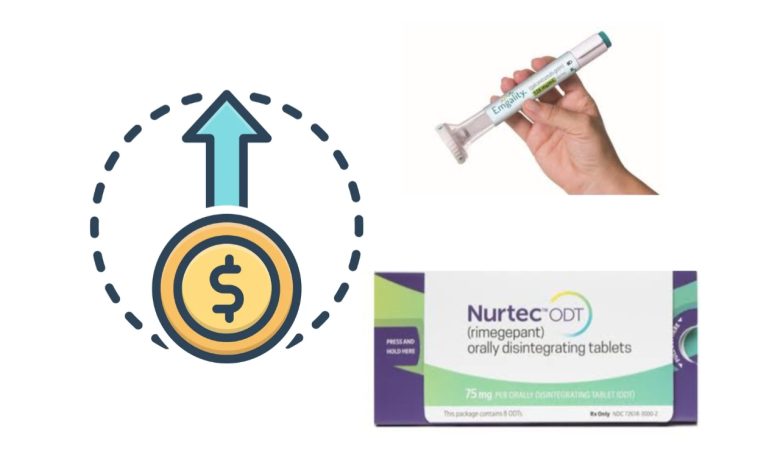Why is Nurtec ODT So Expensive?

In recent years, the pharmaceutical industry has witnessed the advent of groundbreaking treatments designed to alleviate the burden of various medical conditions. One such innovation is Nurtec ODT (orally disintegrating tablet), a medication primarily prescribed for the acute treatment of migraine headaches in adults.
While hailed as a significant advancement in migraine management, Nurtec’s effectiveness comes with a notable caveat – its steep price tag. Let’s delve into what Nurtec is, why it’s considered revolutionary, and the factors contributing to its high cost.
What is Nurtec?
Nurtec ODT, or rimegepant, is a prescription medication developed by Biohaven Pharmaceuticals. It belongs to a class of drugs known as CGRP (calcitonin gene-related peptide) antagonists. CGRP is a neuropeptide involved in the pathophysiology of migraine headaches. By blocking the CGRP receptor, Nurtec helps alleviate migraine symptoms, such as headache pain, nausea, and sensitivity to light and sound.
What sets Nurtec apart from other migraine medications is its rapid onset of action and long-lasting relief. Unlike traditional triptans, which are contraindicated for certain individuals and may cause vasoconstriction, Nurtec does not carry such limitations. Additionally, Nurtec is convenient to administer, as it dissolves quickly on the tongue without the need for water, making it particularly suitable for individuals experiencing nausea during migraine attacks.
Nurtec, was developed by Biohaven Pharmaceuticals. Founded in 2013, Biohaven is a biopharmaceutical company dedicated to advancing therapies for neurological and neuropsychiatric diseases. Headquartered in New Haven, Connecticut, Biohaven has garnered attention within the healthcare industry for its focus on developing novel treatments targeting areas of high unmet medical need.
Leveraging cutting-edge research and development efforts, Biohaven’s scientists identified the potential of CGRP antagonists in migraine management. CGRP is a neuropeptide involved in the pathophysiology of migraines, making it a promising target for therapeutic intervention.
Biohaven’s team embarked on rigorous preclinical studies and clinical trials to evaluate the safety and efficacy of Nurtec. These trials involved assessing Nurtec’s ability to alleviate migraine symptoms, its tolerability, and its impact on patients’ quality of life. Following successful trial results, Biohaven pursued regulatory approvals from health authorities, including the U.S. Food and Drug Administration (FDA), to bring Nurtec to market.
The Cost Conundrum
Despite its efficacy and convenience, Nurtec’s cost has stirred controversy and sparked debate within the healthcare community and among patients. The price of Nurtec can be staggering, often exceeding hundreds of dollars for a single dose or a monthly supply. Several factors contribute to its high cost:
1. Research and Development (R&D) Expenses: Pharmaceutical companies invest substantial resources in research and development to bring new medications to market. Developing a novel drug involves extensive preclinical testing, clinical trials, and regulatory approvals, all of which incur significant expenses. Manufacturers often recoup these costs by pricing the medication accordingly.
2. Limited Competition: As of now, Nurtec is one of the few CGRP antagonists approved for acute migraine treatment. The lack of direct competition allows Biohaven Pharmaceuticals to maintain pricing power in the market.
3. Insurance Coverage and Rebates: While some insurance plans may cover Nurtec, the extent of coverage varies widely. Patients without adequate insurance may face substantial out-of-pocket expenses. To mitigate costs, manufacturers may offer patient assistance programs or negotiate rebates with pharmacy benefit managers, but these measures may not fully alleviate financial burdens for all patients.
4. Patent Protection: Biohaven Pharmaceuticals holds patents for Nurtec, granting them exclusive rights to manufacture and distribute the medication for a specified period. During this patent protection period, generic versions of Nurtec cannot enter the market, further limiting competition and potentially prolonging higher prices.
The cost of Nurtec may also be influenced by its market pricing dynamics. For instance, the cost for Nurtec ODT oral tablet, disintegrating 75 mg, can reach approximately $1,061 for a supply of just 8 tablets, albeit this price may fluctuate depending on the specific pharmacy or healthcare provider visited. Such pricing reflects not only the production and distribution expenses associated with manufacturing Nurtec but also the strategic decisions made by Biohaven Pharmaceuticals regarding pricing strategies and negotiations with insurers and pharmacy benefit managers. Consequently, the relatively high price point for Nurtec may pose challenges for patients seeking affordable access to this innovative migraine treatment option.
Addressing Affordability Challenges
The high cost of Nurtec poses challenges for patients seeking access to effective migraine treatment. To address affordability concerns and improve access, several strategies could be explored:
1. Generic Competition: Encouraging competition from generic manufacturers could drive down prices once Nurtec’s patents expire. Regulatory agencies play a crucial role in expediting the approval of generic equivalents, thereby promoting affordability and accessibility.
2. Price Negotiation and Transparency: Increased transparency in drug pricing and negotiations between pharmaceutical companies, insurers, and pharmacy benefit managers could lead to more equitable pricing structures and better coverage options for patients.
3. Patient Assistance Programs: Enhancing patient assistance programs and co-pay assistance initiatives can help alleviate financial burdens for individuals with limited financial means.
4. Healthcare Policy Reform: Policymakers could explore legislative measures to address the underlying factors contributing to high drug prices, such as reforming patent laws, promoting price transparency, and implementing cost-containment measures.
Conclusion
Nurtec’s high cost can be attributed to several factors, including the extensive research and development investment required for its creation. Biohaven Pharmaceuticals, the company behind Nurtec, invested substantial resources in conducting preclinical studies, clinical trials, and obtaining regulatory approvals, all of which incurred significant expenses. Additionally, Nurtec is a pioneering medication in the field of migraine treatment, offering rapid relief and improved tolerability compared to existing therapies. The lack of direct competition, limited market alternatives, and patent protection further contribute to Nurtec’s pricing power, allowing Biohaven to set the price at a level that reflects the medication’s value and recoups the investment made in its development
Addressing the affordability challenges associated with Nurtec and other high-cost medications requires collaborative efforts from stakeholders across the healthcare continuum to ensure that patients can access the treatments they need without facing undue financial hardship.





